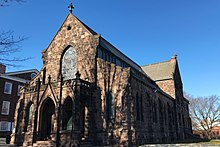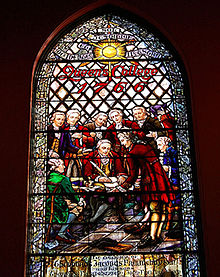
Rutgers University, officially Rutgers, The State University of New Jersey, is a public land-grant research university consisting of four campuses in New Jersey. Chartered in 1766, Rutgers was originally called Queen's College, and was affiliated with the Dutch Reformed Church. It is the eighth-oldest college in the United States, the second-oldest in New Jersey after Princeton University, and one of nine U.S. colonial colleges that were chartered before the American Revolution.
Matthew Leydt (1755–1783) was the first graduate of Queen's College in New Brunswick, New Jersey.
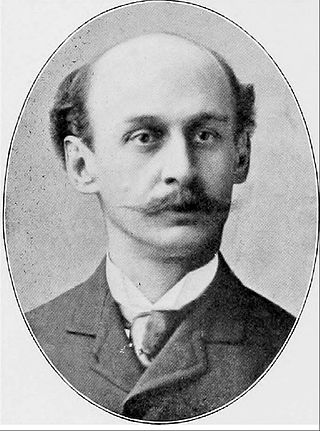
Henry Janeway Hardenbergh FAIA was an American architect, best known for his hotels and apartment buildings, and as a "master of a new building form — the skyscraper." He worked three times with Edward Clark, the wealthy owner of the Singer Sewing Machine Company and real estate developer: The Singer company's first tower in New York City, The Dakota Apartments, and its precursor, the Van Corlear. He is best known for building apartment dwellings and luxury hotels.
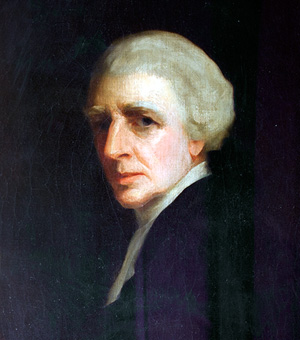
Jacob Rutsen Hardenbergh was an American Dutch Reformed clergyman, colonial and state legislator, and educator. Hardenbergh was a founder of Queen's College—now Rutgers, The State University of New Jersey—in 1766, and was later appointed as the college's first president.

New Brunswick Theological Seminary is a Reformed Christian seminary with its main campus in New Brunswick, New Jersey. It was founded in 1784 and is one of the oldest seminaries in the United States. It is a seminary of the Reformed Church in America (RCA), a mainline Reformed Protestant denomination in Canada and the United States that follows the theological tradition and Christian practice of John Calvin. First established in New York City under the leadership of the Rev. John Henry Livingston, who instructed aspiring ministers in his home, the seminary established its presence in New Brunswick in 1810. Although a separate institution, the seminary's early development in New Brunswick was closely connected with that of Rutgers University before establishing its own campus in the city in 1856. Since 1986, the seminary has also offered classes at a satellite location on the grounds of St. John's University in the Jamaica neighborhood of Queens, New York.

John Frelinghuysen also known as Johannes Frelinghuysen was a minister in colonial New Jersey whose work in education laid the groundwork for the establishment Rutgers University and the New Brunswick Theological Seminary.

The First Reformed Church, historically known as the Dutch Reformed Church, is located in New Brunswick, New Jersey on 160 Neilson Street. It is adjacent to the First Reformed Church Cemetery in the churchyard. The education building is located next to the sanctuary building with the street address being 9 Bayard Street.

Old Queens is the oldest extant building at Rutgers University and is the symbolic heart of the university's campus in New Brunswick in Middlesex County, New Jersey in the United States. Rutgers, the eighth-oldest college in the United States, was founded in 1766 during the American colonial period as Queen's College. Queen's College was named for Charlotte of Mecklenburg-Strelitz, the daughter of a German duke who became the queen consort of British king George III. Old Queens is located on a six-acre hilltop city block bounded by Somerset Street, Hamilton Street, College Avenue and George Street that was previously an apple orchard. Donated to the college in 1807 by James Parker, Jr., this city block become known the Queen's Campus and is the historic core of the university. Because of this, by metonymy, the name "Old Queens" came to be used as a reference to Rutgers College and is often invoked as an allusive reference to the university or to its administration.

Voorhees Mall is a large grassy area with stately shade trees on a block of about 28 acres (0.11 km²) located on the College Avenue Campus of Rutgers University near downtown New Brunswick, New Jersey. An eclectic mix of architectural styles, Voorhees Mall is lined by many historic academic buildings. The block is bound by Hamilton Street, George Street (north), College Avenue (south) and Seminary Place (west). At the mall's western end, across Seminary Place, is the campus of the New Brunswick Theological Seminary, whose history is intertwined with the early history of Rutgers University. Across Hamilton Street is the block called Old Queens, the seat of the university.
Rutgers University is an institution of higher learning with campuses across the State of New Jersey its main flagship campus in New Brunswick and Piscataway, and two other campuses in the cities of Newark and Camden, New Jersey.
Littleton Kirkpatrick was an American Whig Party politician, who represented New Jersey's 4th congressional district in the United States House of Representatives for one term from 1853 to 1855.
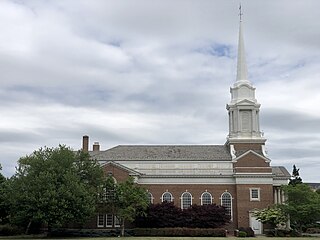
Voorhees Chapel is one of two chapels on the campus of Rutgers, The State University of New Jersey in New Brunswick, New Jersey. Built in 1925 with a donation from Elizabeth Rodman Voorhees, wife of Rutgers trustee Ralph Voorhees, the chapel once served the community of Douglass College. Douglass, founded the New Jersey College for Women, was the women's residential college at Rutgers.

Geology Hall is a historic building on the Queens Campus of Rutgers University, in New Brunswick, New Jersey. It was built from April 1871 to June 1872 to house various science classes and the Rutgers Geology Museum. The museum was established in 1872 by George Hammell Cook, Rutgers' then professor of geology, with a collection of specimens whose assembly began in the 1830s under Cook's predecessor, Lewis Caleb Beck. As classes and offices moved out of the hall, the museum expanded until it occupied the entire hall by the mid-20th century. In 1973, the hall was added to the New Jersey and National Register of Historic Places (NRHP) with Old Queens, President's House, Van Nest Hall, Daniel S. Schanck Observatory, the Kirkpatrick Chapel, and Winants Hall as part of the Old Queens Campus historic district.

Alexander Johnston Hall is a historic building located on the corner of Somerset Street and College Avenue, New Brunswick in Middlesex County, New Jersey and is the second oldest building on the campus of Rutgers University. It was built in 1830 to handle the expansion of the Rutgers Preparatory School and the two literary societies, Philoclean and Peithessophian. The building, described using its historic name, Rutgers Preparatory School, was added to the National Register of Historic Places on July 18, 1975 for its significance in architecture and education.
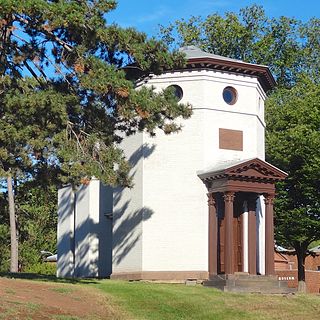
The Daniel S. Schanck Observatory is an historical astronomical observatory on the Queens Campus of Rutgers University in New Brunswick, New Jersey, United States, and is tied for the seventh oldest observatory in the US alongside the Vassar College Observatory. It is located on George Street near the corner with Hamilton Street, opposite the parking lot adjacent to Kirkpatrick Chapel, and to the northeast of Old Queens and Geology Hall.

The Queens Campus or Old Queens Campus is a historic section of the College Avenue Campus of Rutgers, The State University of New Jersey in New Brunswick, New Jersey, in the United States.

The Peithessophian Society of Rutgers College was a student literary and debating society founded in 1825 at Rutgers College in New Brunswick, New Jersey. Founded by Professor James Spencer Canon after Rutgers College reopened after years of financial difficulty and a brief closing, it was one of two such societies at campus in the nineteenth-century—the other being the Philoclean Society. The name "Peithessophian" is derived from the Ancient Greek meaning "persuasiveness of wisdom."
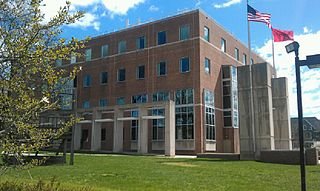
Archibald S. Alexander Library is the oldest and main university library for Rutgers University–New Brunswick. It houses an extensive humanities and social science collection and also supports the work of faculty and staff at four professional schools: the Edward J. Bloustein School of Planning and Public Policy, the Graduate School of Education, the Graduate School of Social Work, and the School of Communication and Information. In addition, Alexander supports major interdisciplinary programs in African studies, Latin American studies, medieval studies, and South Asian Studies.
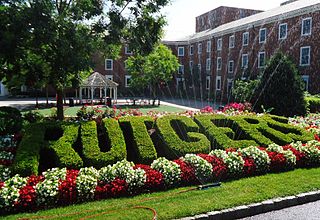
College Avenue is the oldest campus of Rutgers University – New Brunswick, in New Brunswick, New Jersey, U.S. It includes the historic seat of the university, known as Old Queens and the campus of the New Brunswick Theological Seminary. Many classes are taught in the Voorhees Mall area, also home to the Zimmerli Art Museum. It is within walking distance of shops, restaurants, and theaters in downtown New Brunswick and is served by Rutgers Campus Buses, a zero-fare bus network.
